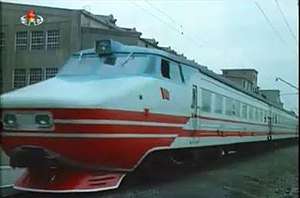Juche-class EMU
The Juche-class (Korean: 주체) is a 4-part electric multiple unit built by the Kim Chong-t'ae Electric Locomotive Works in 1976, intended for high speed train service for the Korean State Railway.[1]
| Juche | |||||||||||
|---|---|---|---|---|---|---|---|---|---|---|---|
 The Juche-class EMU at its unveiling after refurbishment. | |||||||||||
| |||||||||||
| |||||||||||
| |||||||||||
Description
Electric railcars had been used in Korea before the war by the Kŭmgangsan Electric Railway,[2] and these were used by Korean State Railway until the line was destroyed during the Korean War,[3] and no further electric railcars were used after that for many years. However, the opening of the P'yŏngyang Metro in 1973, along with worldwide attention on high-speed electric trainsets such as the Japanese Shinkansen put into service in 1964[4] and the ER200 class introduced by the Soviet Railways in 1974,[5] led the Railway Ministry to direct efforts towards the development of a high-speed train for North Korea, resulting the unveiling of North Korea's first electric trainset, the Juche-class EMU, in 1976.[1] Externally, the four-car set was similar in appearance to the 181 series trainsets used by the Japanese National Railways on the Kodama limited express of the day; internally, despite all of North Korea's electrification being 3000 V DC, the Juche-class EMU was built for two-system operation - possibly with a view to future operation in South Korea, where AC electrification was used.[6]
Operation
Trials were carried out around P'yŏngyang, but no further sets were built,[6] suggesting that the experiment was deemed a failure. The set remained in storage until 1998, when it was refurbished, repainted, and put into use on a daily commuter service for scientists between P'yŏngyang and Paesanjŏm, taking one hour to cover the 38 km (24 mi) distance each way.[1]
References
- Kokubu, Hayato, 将軍様の鉄道 (Shōgun-sama no Tetsudō), p. 95, ISBN 978-4-10-303731-6
- "鉄道省革命事績館". www.2427junction.com.
- 《기차시간표》(1950년 4월 1일 개정), 북한 교통성 운수국 렬차부 편
- Semmens, Peter (1997). High Speed in Japan: Shinkansen - The World's Busiest High-speed Railway. Sheffield, UK: Platform 5 Publishing. ISBN 1-872524-88-5.
- Dymant, Yu., Скоростной поезд ЭР200, Наука и жизнь, issue 6, 1974, pp. 42-44
- Kokubu, Hayato, 将軍様の鉄道 (Shōgun-sama no Tetsudō), p. 77, ISBN 978-4-10-303731-6